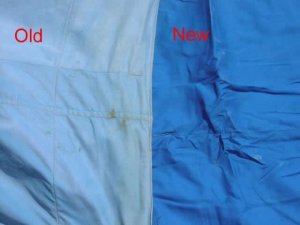How many tsetse can a trap catch?

Well! That depends on how many tsetse are present: in Somalia, an F3 trap baited with acetone, octenol and phenols caught more than 9000 G. pallidipes in a day but after the area had been sprayed, it caught none.
An odour-baited Epsilon trap catches about 1-2% of the G. pallidipes population in the square kilometre surrounding the trap each day (Barclay & Hargrove, 2005) - thus for every fly that we catch there are roughly 100 that we didn't.
Even for the most efficient traps, about half the tsetse approaching the trap ultimately manage to escape capture (Vale & Hargrove, 1979). And if the trap is in a poor site, is faded, has holes in the netting or does not have the appropriate odour (Vale 1999, Green & Flint, 1986), then the proportion escaping is increased even further.
The darker-coloured cloth on the right is from a new trap whereas that from the left is from a trap that has been in use for several months. Fading like this can half the effectiveness of a trap.
So catching tsetse when the population is low is very difficult. The important point to remember is that not catching tsetse does not mean that none is present - it just means that you haven't caught any. On the other hand, if you catch tsetse that means there are probably lots of them out there.
References
Barclay, H.J. & Hargrove, J.W. (2005). Probability models to facilitate a declaration of pest-free status, with special reference to tsetse (Diptera: Glossinidae). Bulletin of Entomological Research 95, 1-11.
Vale, G. A. & Hargrove, J.W. (1979). A method for studying the efficiency of traps for tsetse flies (Diptera: Glossinidae) and other insects. Bulletin of Entomological Research 69, 183-193.
Vale, G.A. (1999) Responses of tsetse flies (Diptera: Glossinidae) to vegetation in Zimbabwe: implications for population distribution and bait siting. Bulletin of Entomological Research 88, Supplement 1, S7-S59.
Green, C.H. & Flint, S. (1986) An analysis of colour effects in the performance of the F2 trap against G. pallidipes Austen and G. morsitans morsitans Westwood (Diptera: Glossinidae). Bulletin of Entomological Research,76, 409-418.